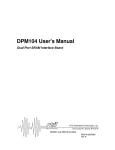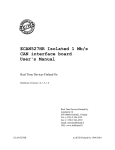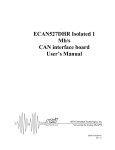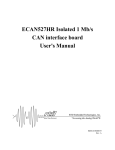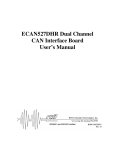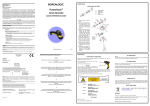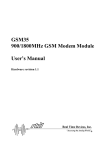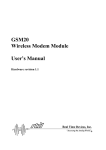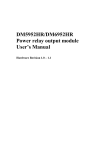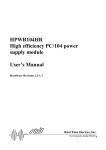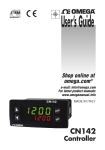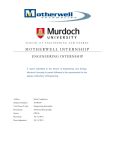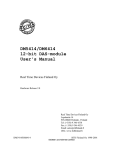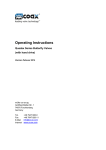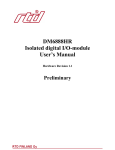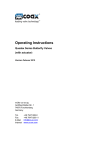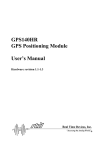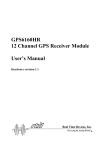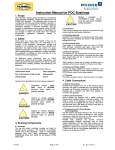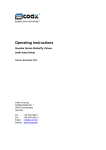Download DPM104HR Dual Port SRAM Interface Board User`s Manual
Transcript
DPM104HR Dual Port SRAM Interface Board User's Manual Real Time Devices Finland Oy HARDWARE RELEASE 2.1 Real Time Devices Finland Oy Lepolantie 14 FIN-00660 Helsinki, Finland Tel: (+358) 9 346 4538 Fax: (+358) 9 346 4539 Email: [email protected] URL: www.rtdfinland.fi DPM104HR (c) RTD Finland Oy 1997-2001 IMPORTANT Although the information contained in this manual has been carefully verified, RTD Finland Oy assumes no responsibility for errors that might appear in this manual, or for any damage to things or persons resulting from improper use of this manual or from the related software. RTD Finland Oy reserves the right to change the contents of this manual, as well as the features and specifications of this product at any time, without notice. Published by Real Time Devices Finland Oy Lepolantie 14 FIN-00660 Helsinki, Finland Copyright © 1997-2001 by RTD Finland Oy All rights reserved Printed in Finland DPM104HR (c) RTD Finland Oy 1997-2001 Table of Contents Page =============================================================== INTRODUCTION Dual Port Memory Mechanical description Connector description What comes with your board Board accessories Application software and drivers Hardware accessories Using this manual When you need help CHAPTER 1 - BOARD SETTINGS Factory configured jumper settings Base address jumpers Interrupt channels CHAPTER 2 - BOARD INSTALLATION Board installation CHAPTER 3 - HARDWARE DESCRIPTION Dual Port Memory Interrupts Semaphores Backup Battery connection CHAPTER 4 - BOARD OPERATION AND PROGRAMMING Defining the memory map DPM datasheet reprint from IDT Interrupts What is an interrupt? Interrupt request lines 8259 Programmable interrupt controller Interrupt mask register (IMR) End-Of-Interrupt (EOI) Command What exactly happens when an interrupt occurs? Using interrupts in your program Writing an interrupt service routine (ISR) Saving the startup IMR and interrupt vector Common Interrupt mistakes APPENDIX A - DPM104HR Specifications DPM104HR (c) RTD Finland Oy 1997-2001 List of Illustrations Page =============================================================== To be completed later DPM104HR (c) RTD Finland Oy 1997-2001 Page 1 INTRODUCTION =============================================================== DPM104HR (c) RTD Finland Oy 1997-2001 Page 2 This user's manual describes the operation of the DPM104HR Dual Port Memory interface board. Some of the key properties of the DPM104HR include: 8K x 16 True Dual Ported memory cells with simultaneous reads from the same memory location Mapped into 18KB of host low memory On-chip arbitration logic Full on-chip hardware and software for semaphore signalling between ports Full asyncronous operation from either port Interrupts from both sides Backup with external battery and power supply supervisor +5V only operation -40 to +85C Operating temperature range PC/104 compliant The following paragraphs briefly describe the major features of the DPM104HR. A more detailed discussion is included in Chapter 3 (Hardware description) and in Chapter 4 (Board operation and programming. The board setup is described in Chapter 1 (Board Settings). A full description of the Dual Port Memory chip is included in Chapter 4. Dual Port Memory The DPM104HR dual port memory interface is implemented using monolithic memory chip. This chip provides a high speed low power asyncronous acess to a total of 16 KB of RAM memory. Inter-port arbitratration is integrated into the chip. To enable high speed data t ransfers hardware semaphores and interrupts are supported. To maintain memory contents in cases of power loss an external battery may be used to provide power for the memory. Mechanical description The DPM104HR is designed on a PC/104 form factor. An easy mechanical interface to PC/104 systems can be achieved. Stack two PC/104 compliant cpuModules directly on your DPM104HR using the onboard mounting holes. Connector description There are two 16-bit PC/104 bus connectors on the DPM104HR to directly interface to two cpuModules with 16-bit busses. One connector on the top side of the board is the Master side of the DPM and the other connector on the bottom of the board is the Slave side. DPM104HR (c) RTD Finland Oy 1997-2001 Page 3 Note! Only 16-bit CPU bus boards may be used with the DPM104HR. What comes with your board You receive the following items in your DPM104HR package: * DPM104HR Dual Port Memory interface module * User's manual Note: DOS/WIN95/98/2000/NT 4.0 drivers and test software are available from our website at www.rtdfinland.fi. If any item is missing or damaged, please call Real Time Devices Finland customer service department at (+358) 9 346 4538. Board accessories In addition to the items included in your DPM104HR delivery several software and hardware accessories are available. Call your distributor for more information on these accessories and for help in choosing the best items to support your distributed control system. Using this manual This manual is intended to help you install your new DPM104HR card and get it running quickly, while also providing enough detail about the board and it's functions so that you can enjoy maximum use of it's features even in the most demanding applications. When you need help This manual and all the example programs will provide you with enough information to fully utilize all the features on this board. If you have any problems installing or using this board, contact our Technical Support Department (+358) 9 346 4538 during European business hours, or send a FAX to (+358) 9 346 4539 or Email to [email protected]. When sending a FAX or Email request, please include your company's name and address, your name, your telephone number, and a brief description of the problem. DPM104HR (c) RTD Finland Oy 1997-2001 Page 4 CHAPTER 1 - BOARD SETTINGS =============================================================== The DPM104HR board has jumper settings you can change to suit your application and host computer memory configuration. The factory settings are listed and shown in the diagram in the beginning of this chapter. DPM104HR (c) RTD Finland Oy 1997-2001 Page 5 Factory configured Jumper Settings Table 1-1 illustrates the factory jumper setting for the DPM104HR. Figure 1-1 shows the board layout of the DPM104HR and the locations of the jumpers. The following paragraphs explain how to change the factory jumper settings to suit your specific application. Table 1-1 Factory configured jumper settings see figure 1-1 for detailed locations JUMPER NAME DESCRIPTION OF JUMPER NUMBER OF JUMPERS FACTORY SETTING JUMPERS INSTALLED ADDR_A ADDR_B IRQ_A IRQ_B BASE ADDRESS BASE ADDRESS HOST INTERRUPT HOST INTERRUPT 5 5 5 5 D8000 D8000 Not connected Not connected Fig. 1-1 - Board layout showing jumper locations DPM104HR (c) RTD Finland Oy 1997-2001 Page 6 Base Address Jumpers (Factory setting: D8000h) The DPM104HR is memory mapped into the low memory of your host computer. The board occupies a memory window of 18KB starting from the base address. The most common cause of failure when you are first setting up your module is address contention. Some of your computers memory space is already occupied by other devices and memory resident programs. When the DPM104HR attempts to use it's reserved memory addresses already used by another device, erratic performance may occur and data read from the board may be corrupted. To avoid this problem make sure you set up the base address first using the 5 jumpers marked "ADDR" which let you choose from number of addresses in your host computers memory map. Should the factory installed setting of D8000h be unusable for your system configuration, you may change this setting to another using the options illustrated in Table 1-2 and in Figures 1-2 and 1-3 . The table shows the jumper settings and their corresponding values in hexadecimal values. Make sure you verify the correct location of the base address jumpers. When the jumper is removed it corresponds to a logical "1", connecting the jumper to a "0". When you set the base address of the module, record the setting in the table inside the back cover of this manual after the Appendices. Note: If you are using a memory manager such as QEMM, make sure you exclude the memory section you are occupying by the DPM104HR; for example X=D000-D8FF. DPM104HR (c) RTD Finland Oy 1997-2001 Page 7 Address Settings for DPM104HR Base Address Hex Jumper Settings 18 17 16 1 80XXX 0 0 0 0 88XXX 0 0 0 1 90XXX 0 0 1 0 98XXX 0 0 1 1 A0XXX 0 1 0 0 A8XXX 0 1 0 1 B0XXX 0 1 1 0 B8XXX 0 1 1 1 C0XXX 1 0 0 0 C8XXX 1 0 0 1 D0XXX 1 0 1 0 D8XXX 1 0 1 1 E0XXX 1 1 0 0 E8XXX 1 1 0 1 F0XXX 1 1 1 0 F8XXX 1 1 1 1 1 = NO JUMPER, 0 = JUMPER installed Note : A19 is always decoded as 1 ! Table 1-2 Base address jumper settings Note: The above table illustrates only the settings for the address bits A18-A15. Address line A19 should always be decoded as "1" since low memory area 00000 -7ffff is normally occupied by the system. DPM104HR (c) RTD Finland Oy 1997-2001 Page 8 Fig. 1-2 Base address jumpers for side A (Master) Fig. 1-3 Base address jumpers for side B (Slave) DPM104HR (c) RTD Finland Oy 1997-2001 Page 9 Interrupt Channel A (Factory setting: Not connected) The header connector, shown on Figure 1-4a, lets you connect the onboard DPM master side interrupt output to one of the interrupt channels available on the host AT bus. Fig. 1-4a Interrupt jumpers for side A The header connector, shown on Figure 1-4b, lets you connect the onboard DPM slave side interrupt output to one of the interrupt channels available on the host AT bus. Fig. 1-4b Interrupt jumpers for side B DPM104HR (c) RTD Finland Oy 1997-2001 Page 10 CHAPTER 2 - BOARD INSTALLATION =============================================================== The DPM104HR memory interface board is very easy to connect to your industrial distributed control system. Direct interface two PC/104 computers in one stack! This chapter tells you step-by-step how to install your DPM104HR into your system. DPM104HR (c) RTD Finland Oy 1997-2001 Page 11 Board Installation Keep your board in its antistatic bag until you are ready to install it to your system! When removing it from the bag, hold the board at the edges and do not touch the components or connectors. Please handle the board in an antistatic environment and use a grounded workbench for testing and handling of your hardware. Before installing the board in your computer, check the jumper settings. Chapter 1 reviews the factory settings and how to change them. If you need to change any settings, refer to the appropriate instructions in Chapter 1. Note that incompatible jumper settings can result in unpredictable board operation and erratic response. General installation guidelines: 1. Turn OFF the power to your computer and all devices connected to DPM104HR 2. Touch the grounded metal housing of your computer to discharge any antistatic buildup and then remove the board from its antistatic bag. 3. Hold the board by it's edges and install it in an enclosure or place it on the table on an antistatic surface. 4. Connect the board to the two PC/104 cpuModules using the two bus interface connectors. Installation integrated with a PC/104 module stack: * Secure the two PC/104 installation holes opposite to the bus connectors with standoffs. * Connect the DPM104HR board to the two PC/104 cpuModules using the two bus interface connectors. DPM104HR (c) RTD Finland Oy 1997-2001 Page 12 Fig. 2-1 DPM104HR integrated with two PC/104 cpuModule stacks Note: The default connectors on the DPM104HR are two soldertail PC/104 bus connectors. Other connector options are available upon request. DPM104HR (c) RTD Finland Oy 1997-2001 Page 13 CHAPTER 3 - HARDWARE DESCRIPTION =============================================================== Chapter 3 - Hardware Description describes the major features of the DPM104HR: the Dual Port Memory chip, Interrupts , Semaphores and Backup battery supply. DPM104HR (c) RTD Finland Oy 1997-2001 Page 14 Figure 3-1 shows the general block diagram of the DPM104HR. This chapter describes the major features of the DPM104HR: the Dual Port Memory chip, Interrupts and the Battery supply. Fig. 3-1 DPM104HR Block diagram DPM104HR (c) RTD Finland Oy 1997-2001 Page 15 Dual Port Memory chip The onboard memory is a 8K x 16 Dual port static RAM. The device provides two independent ports with separate control, access and I/O pins that permit independent, asyncronous access for reads and writes to any location in the memory. Automatic powerdown in activated when the chip is not addressed. Interrupts and semaphores are supported, the onchip busy flag is not used. Interrupts If you wish to use the interrupt supported by the Dual port memory chips, a memory mailbox is assigned to each port. The Slave port interrupt flag is set when the Master port writes to memory location FFE (hex). The Slave port clears the interrupt by reading the same address. Likewise for the Master writing to address FFF (hex). The messages at addresses FFE and FFF (hex) are user definable. Refer to component specific datasheet for more detailed information on the functionality of interrupts. Semaphores The Dual port RAM chip has eight locations dedicated to binary semaphore flags. These flags allow the CPU on the Slave or Master side to claim a priviledge over the other CPU for functions defined by the system software. As an example, the semaphore can be used by one CPU to inhibit the other CPU from accessing blocks of memory or shared resources. Software handshaking between CPU's offers the maximum in system flexibility by permitting shared resources to be allocated in various system configurations. The DPM chip does not use the semaphore to control any resources through hardware, thus allowing the system designer maximum flexibility. Refer to component specific datasheet for more detailed information on how to use semaphores. Battery supply The DPM104HR board has an onboard power supply supervisor to monitor the RAM supply voltage. A small 10 micro Farad charge capacitor will provide enough power for small transient power losses. This capacitor is kept in charge while power is maintained normally. For completely non volatile operation an external 3,6V battery must be used in header connector X1 located next to the Master 16-bit PC/104 bus connector. The polarity of the battery is important, see picture below for correct connection of the external battery. Pin 1 - GND (square pad) Pin 2 - 3,6V battery power DPM104HR (c) RTD Finland Oy 1997-2001 Page 16 CHAPTER 4 - BOARD OPERATION AND PROGRAMMING =============================================================== This chapter shows you how to program and use your DPM104HR. It provides a complete detailed description of the memory map and a detailed discussion of programming operations to aid you in programming. The full functionality of the Dual Port Memory chip is described in the datasheet reprint from IDT. You may use the diagnostics and software supplied by RTD to fully test your system under different operating systems. Please download the latest drivers and software form our website: <www.rtdfinland.fi>. DPM104HR (c) RTD Finland Oy 1997-2001 Page 17 Defining the Memory Map The memory map of the DPM memory occupies 18 Kbytes of host CPU memory space. This window is freely selectable by the user as described in Chapter 1, Table 1-2. After setting the base address you have access to the internal resources of the DPM-chip as described in the next sections reprinted from the IDT chip datasheet. The memory map of the DPM chip resources is illustrated in the table below. Address Range in HEX Memory Resources 000-1FFE Dual Port Memory mailbox area 1FFE Interrupt clear for Master (Read) 1FFE Interrupt to Master (Write) 1FFF Interrupt clear for Slave (Read) 1FFF Interrupt to Slave (Write) 2000-2008 Semaphore bits for both sides DPM104HR (c) RTD Finland Oy 1997-2001 Page 18 DPM104HR (c) RTD Finland Oy 1997-2001 Page 19 DPM104HR (c) RTD Finland Oy 1997-2001 Page 20 DPM104HR (c) RTD Finland Oy 1997-2001 Page 21 DPM104HR (c) RTD Finland Oy 1997-2001 Page 22 DPM104HR (c) RTD Finland Oy 1997-2001 Page 23 DPM104HR (c) RTD Finland Oy 1997-2001 Page 24 DPM104HR (c) RTD Finland Oy 1997-2001 Page 25 DPM104HR (c) RTD Finland Oy 1997-2001 Page 26 Interrupts - What is an interrupt ? An interrupt is an event that causes the processor in your computer to temporarily halt its current process and execute another routine. Upon completion of the new routine, control is returned to the original routine at the point where its execution was interrupted. Interrupts are a very flexible way of dealing with asynchronous events. Keyboard activity is a good example; your computer cannot predict when you might press a key and it would be a waste of processor time to do nothing while waiting for a keystroke to occur. Thus the interrupt scheme is used and the processor proceeds with other tasks. Then when a keystroke occurs, the keyboard 'interrupts' the processor , and the processor gets the keyboard data, placed it into memory, and then returns to what it was doing before the interrupt occurred. Other common devices that use interrupts are network boards, A/D boards, serial ports etc. You can interrupt the other processor on the other side of the DPM by writing to the topmost addresses of the memory at addresses 1FFE and 1FFF. When an interrupt is received you may signal that data has been updated in the memory. By using interrupts you can write powerful code to interface to your DPM104HR. -Interrupt request lines To allow different peripheral devices to generate interrupts on the same computer, the PC AT bus has interrupt request channels (IRQ's). A rising edge transition on one of these lines will be latched into the interrupt controller. The interrupt controller checks to see if the interrupts are to be acknowledged from that IRQ and, if another interrupt is being processed, it decides if the new request should supersede the one in progress or if it has to wait until the one in progress is done. The priority level of the interrupt is determined by the number of the IRQ; IRQ0 has the highest priority IRQ15 the lowest. Many of the IRQ's are used by the standard system resources. IRQ0 is dedicated for the internal timer, IRQ1 is dedicated to the keyboard input, IRQ3 for serial port COM2 and IRQ4 for serial port COM1. Often interrupts 3,5 and 7 are free for the user. - 8259 Programmable Interrupt Controller The chip responsible for handling interrupt requests in a PC is the 8259 Interrupt Controller. To use interrupts you will need to know how to read and set the 8259's internal interrupt mask register (IMR) and how to send the end-of-interrupt (EOI) command to acknowledge the 8259 interrupt controller. DPM104HR (c) RTD Finland Oy 1997-2001 Page 27 -Interrupt Mask Register (IMR) Each bit in the interrupt mask register (IMR) contains the mask status of the interrupt line. If a bit is set (equal to 1), then the corresponding IRQ is masked, and it will not generate an interrupt. If a bit is cleared (equal to 0), then the corresponding IRQ is not masked, and it can generate an interrupt. The interrupt mask register is programmed through port 21h. -End-of-Interrupt (EOI) Command After an interrupt service routine is complete, the 8259 Interrupt Controller must be acknowledged by writing the value 20h to port 20h. -What exactly happens when an interrupt occurs? Understanding the sequence of events when an interrupt is triggered is necessary to correctly write interrupt handlers. When an interrupt request line is driven high by a peripheral device (such as the ECAN527), the interrupt controller checks to see if interrupts are enabled for that IRQ, and then checks to see if other interrupts are active or requested and determines which interrupt has priority. The interrupt controller then interrupts the processor. The current code segment (CS), instruction pointer (IP), and flags are pushed onto the system stack., and a new set if CS and IP are loaded from the lowest 1024 bytes of memory. This table is referred to as the interrupt vector table and each entry to this table is called an interrupt vector. Once the new CS and IP are loaded from the interrupt vector table, the processor starts to execute code from the new Code Segment (CS) and from the new Instruction Pointer (IP). When the interrupt routine is completed the old CS and IP are popped from the system stack and the program execution continues from the point it was interrupted. -Using Interrupt in your Program Adding interrupt support to your program is not as difficult as it may seem especially when programming under DOS. The following discussion will cover programming under DOS. Note, that even the smallest mistake in your interrupt program may cause the computer to hang up and will only restart after a reboot. This can be frustrating and time-consuming. -Writing an Interrupt Service Routine (ISR) The first step in adding interrupts to your software is to write an interrupt service routine (ISR). This is the routine that will be executed automatically each time an interrupt request occurs for the specified IRQ. An ISR is different from other subroutines or procedures. First, on entrance the processor registers must be pushed onto the stack before anything else! Second, just before exiting the routine, you must clear the interrupt on the DPM104HR and write the EOI command to the interrupt controller. Finally, when exiting the interrupt routine the processor registers must DPM104HR (c) RTD Finland Oy 1997-2001 Page 28 be popped from the system stack and you must execute the IRET assembly instruction. This instruction pops the CS, IP and processor flags from the system stack. These were pushed onto the stack when entering the ISR: Most compilers allow you to identify a function as an interrupt type and will automatically add these instructions to your ISR with one exception: most compilers do not automatically add the EOI command to the function, you must do it yourself. Other than this and a few exceptions discussed below, you can write your ISR as any code routine. It can call other functions and procedures in your program and it can access global data. If you are writing your first ISR, we recommend you stick to the basics; just something that enables you to verify you have entered the ISR and executed it successfully. For example: set a flag in your ISR and in your main program check for the flag. Note: If you choose to write your ISR in in-line Assembly , you must push and pop registers correctly, and exit the routine with the IRET instruction instead of the RET instruction. There are a few precautions you must consider when writing ISR's. The most important is, do not use any DOS functions or functions that call DOS functions from an interrupt routine. DOS is not reentrant; that is, a DOS function cannot call itself. In typical programming, this will not happen because of the way DOS is written. But what about using interrupts? Then, you could have the situation such as this in your program. If DOS function X is being executed when an interrupt occurs and the interrupt routine makes a call to the DOS function X, then function X is essentially being called while active. Such cases will cause the computer to crash. DOS does not support such operation. A general rule is , that do not call any functions that use the screen, read keyboard input and any file I/O routines should not be used in ISR's. The same problem of reentrancy exists for many floating point emulators as well, meaning you should avoid floating point mathematical operations in your ISR. Note, that the problem of reentrancy exists, no matter what programming language you use. Even, if you are writing your ISR in Assembly language, DOS and many floating point emulators are not reentrant. Of course, there are ways to avoid this problem, such as those which involve checking if any DOS functions are currently active when your ISR is called, but such solutions are beyond the scope of this manual. The second major concern when writing ISR's is to make them as short as possible in term of execution time. Spending long times in interrupt service routines may mean that other important interrupts are not serviced. Also, if you spend too long in your ISR, it may be called again before you have exited. This will lead to your computer hanging up and will require a reboot. DPM104HR (c) RTD Finland Oy 1997-2001 Page 29 Your ISR should have the following structure: Push any processor registers used in your ISR. Most C compiler do this automatically Put the body of your routine here Read interrupt status address of your DPM104HR board to clear interrupt Issue the EOI command to the 8259 by writing 20h to address 20h Pop all registers. Most C compilers do this automatically The following C example shows what the shell of your ISR should be like: /*------------------------------------------------------------------------------| Function: new_IRQ_handler | Inputs: Nothing | Returns: Nothing - Sets the interrupt flag for the EVENT. |-------------------------------------------------------------------------------*/ void interrupt far new_IRQ_handler(void) { IRQ_flag = 1; // Indicate to main process interrupt has occurred { // Your program code should be here } // Read address 1FFE or 1FFF to // Clear interrupt outp(0x20, 0x20); /* Acknowledge the interrupt controller. */ } -Saving the Startup Interrupt Mask Register (IMR) and interrupt vector The next step after writing the ISR is to save the startup state of the interrupt mask register (IMR) and the original interrupt vector you are using. The IMR is located in address 21h. The interrupt vector you will be using is located in the interrupt vector table which is an array of 4-byte pointers (addresses) and it is located in the first 1024 bytes of the memory (Segment 0 offset 0). You can read this value directly, but it is a better practice to use DOS function 35h (get interrupt vector) to do this. Most C compilers have a special function available for doing this. The vectors for the hardware interrupts on the XT - bus are vectors 8-15, where IRQ0 uses vector 8 and IRQ7 uses vector 15. Thus if your DPM104HR is using IRQ5 it corresponds to vector number 13. Before you install your ISR, temporarily mask out the IRQ you will be using. This prevents the IRQ from requesting an interrupt while you are installing and initializing your ISR. To mask the IRQ, read the current IMR at I/O port 21h, and set the bit that corresponds to your IRQ. The IMR is arranged so that bit 0 is for IRQ0 and bit 7 is for IRQ7. See the paragraph DPM104HR (c) RTD Finland Oy 1997-2001 Page 30 entitled Interrupt Mask Register (IMR) earlier in this discussion for help in determining your IRQ's bit. After setting the bit, write the new value to I/O port 21h. With the startup IMR saved and the interrupts temporarily disabled, you can assign the interrupt vector to point to your ISR. Again you can overwrite the appropriate entry in the vector table with a direct memory write, but this is not recommended. Instead use the DOS function 25h (Set Interrupt Vector) or, if your compiler provides it, the library routine for setting up interrupt vectors. Remember , that interrupt vector 8 corresponds to IRQ0, vector 9 for IRQ1 etc. If you need to program the source of your interrupts, do that next. For example, if you are using transmitted or received messages as an interrupt source , program it to do that. Finally, clear the mask bit for your IRQ in the IMR. This will enable your IRQ. -Common Interrupt mistakes Remember, hardware interrupts are from 8-15, XT IRQ's are numbered 0-7 Forgetting to clear the IRQ mask bit in the IMR Forgetting to send the EOI command after ISR code. Disables further interrupts. Example on Interrupt vector table setup in C-code: void far _interrupt new_IRQ1_handler(void ); #define IRQ1_VECTOR 3 void (interrupt far *old_IRQ1_dispatcher) (es,ds,di,si,bp,sp,bx,dx,cx,ax,ip,cs,flags); void far _interrupt new_IRQ1_handler(void ); /* ISR function prototype */ /* Name for IRQ */ /* Variable to store old IRQ_Vector */ /*---------------------------------------------------------------------| Function: init_irq_handlers | Inputs: Nothing | Returns: Nothing | Purpose: Set the pointers in the interrupt table to point to | our funtions ie. setup for ISR's. |----------------------------------------------------------------------*/ void init_irq_handlers(void) { _disable(); old_IRQ1_handler = _dos_getvect(IRQ1_VECTOR + 8); _dos_setvect(IRQ1_VECTOR + 8, new_IRQ1_handler); Gi_old_mask = inp(0x21); outp(0x21,Gi_old_mask & ~(1 << IRQ1_VECTOR)); _enable(); } DPM104HR (c) RTD Finland Oy 1997-2001 Page 31 |/*---------------------------------------------------------------------| Function: restore do this before exiting program | Inputs: Nothing | Returns: Nothing | Purpose: Restore interrupt vector table. |----------------------------------------------------------------------*/ void restore(void) { /* Restore the old vectors */ _disable(); _dos_setvect(IRQ1_VECTOR + 8, old_IRQ1_handler); outp(0x21,Gi_old_mask); _enable(); } DPM104HR (c) RTD Finland Oy 1997-2001 Page 32 APPENDIX A ==================================================================== DPM104HR Specifications Host Interface Memory mapped into low memory Jumper-selectable base address 16-bit data bus Jumper selectable interrupts XT and AT 16Kbytes Connectors Host bus (Master / Slave side) 16-bit PC/104 busses Electrical Operating temperature range Supply voltage Power consumption DPM104HR -40 to +85C +5V only 1,25W (c) RTD Finland Oy 1997-2001 Page 33 NOTES: (C) RTD Finland Oy 1997-2001 DOC: DPM104HR.SAM DPM104HR (c) RTD Finland Oy 1997-2001





































